Built-In Piezoelectric Nanogenerators Promote Sustainable and Flexible Supercapacitors: A Review
Abstract
:1. Introduction
2. Working Mechanism
2.1. Working Mechanism of PENGs
2.2. Working Mechanism of Supercapacitors
2.2.1. Electric Double-Layer Capacitors
2.2.2. Pseudocapacitors
2.2.3. Hybrid Capacitors
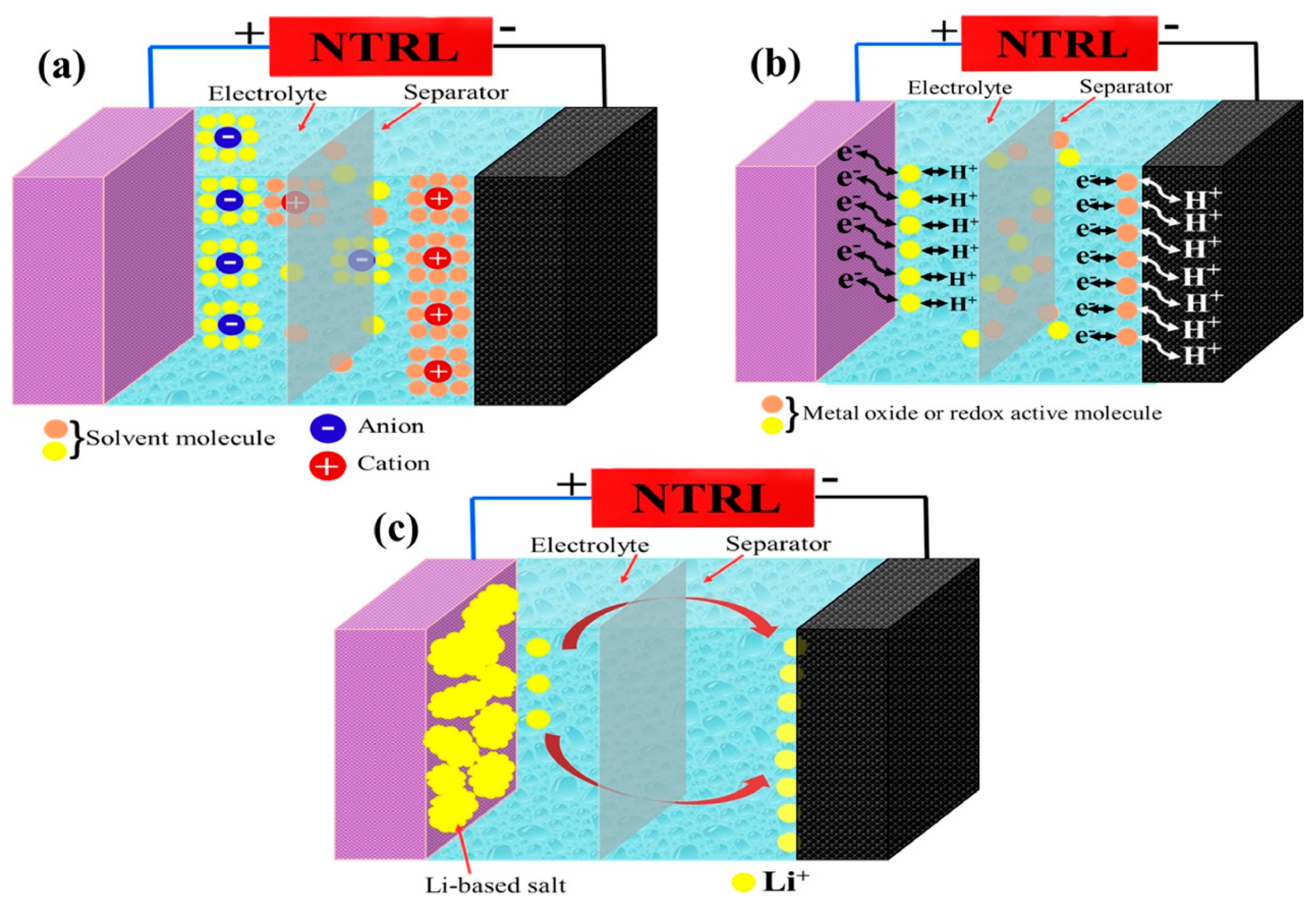
2.3. Working Mechanism of Self-Charging Piezoelectric Supercapacitors (SCPSCs)
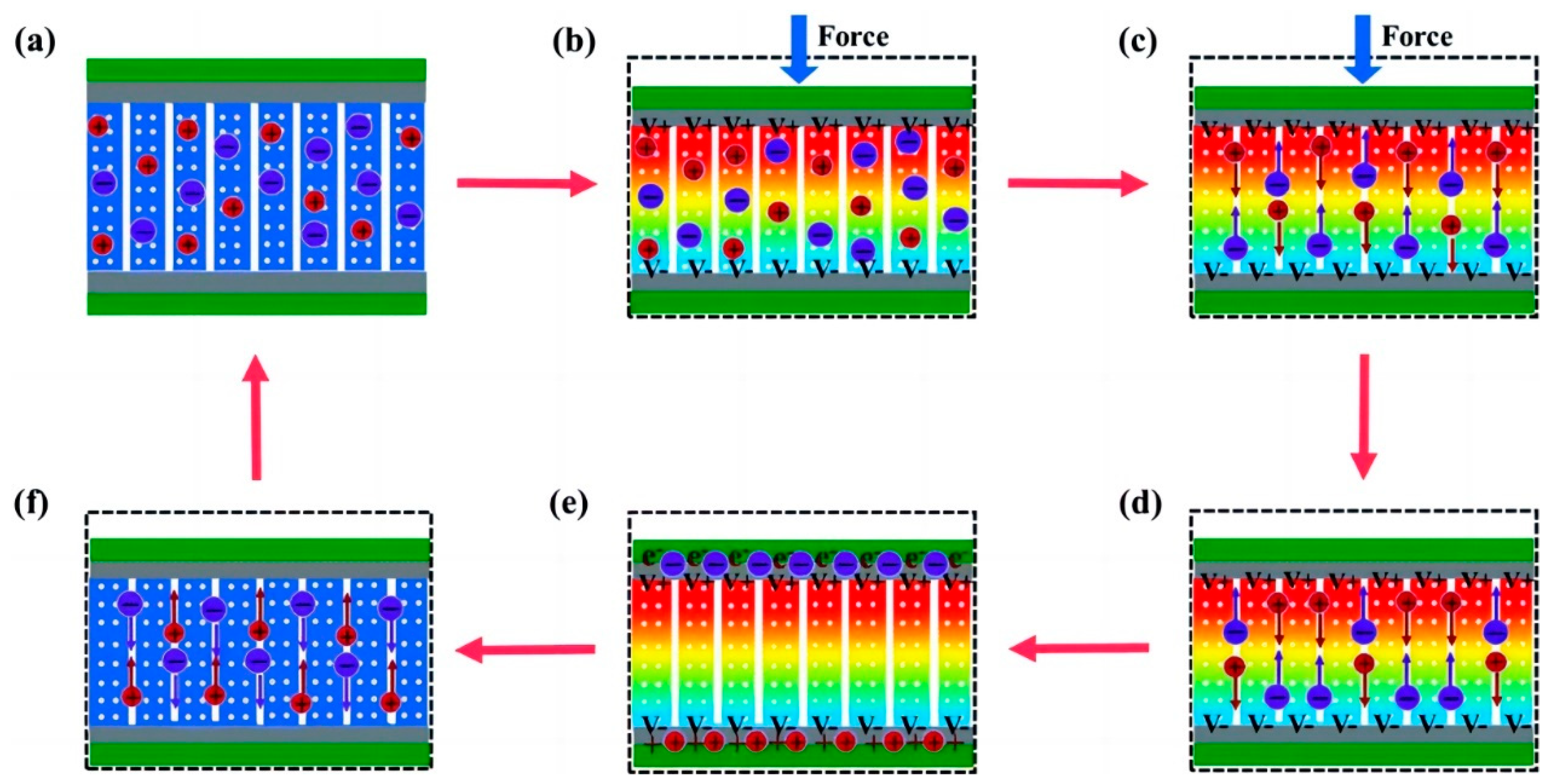
3. Current Progress of the PENG-Based Self-Charged System
3.1. Structure Configuration of SCPSCs
3.2. Material Selection
3.2.1. Flexible SCPSCs Based on Piezoelectric Electrodes
3.2.2. Flexible SCPSCs Based on Gel Polymer Electrolyte (GPE)
3.2.3. Flexible SCPSCs Based on Piezoelectric Polymer Separators
- PVDF
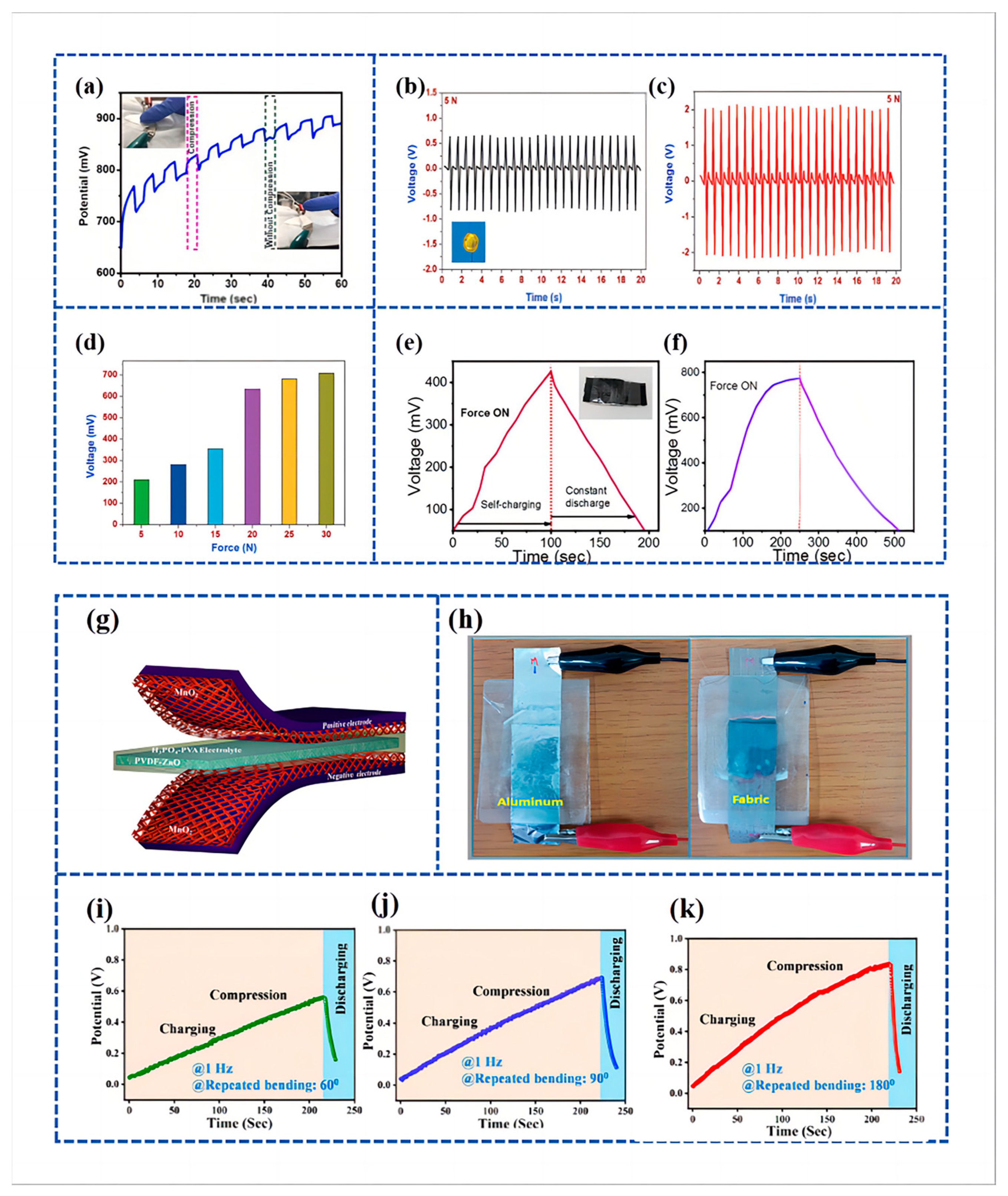
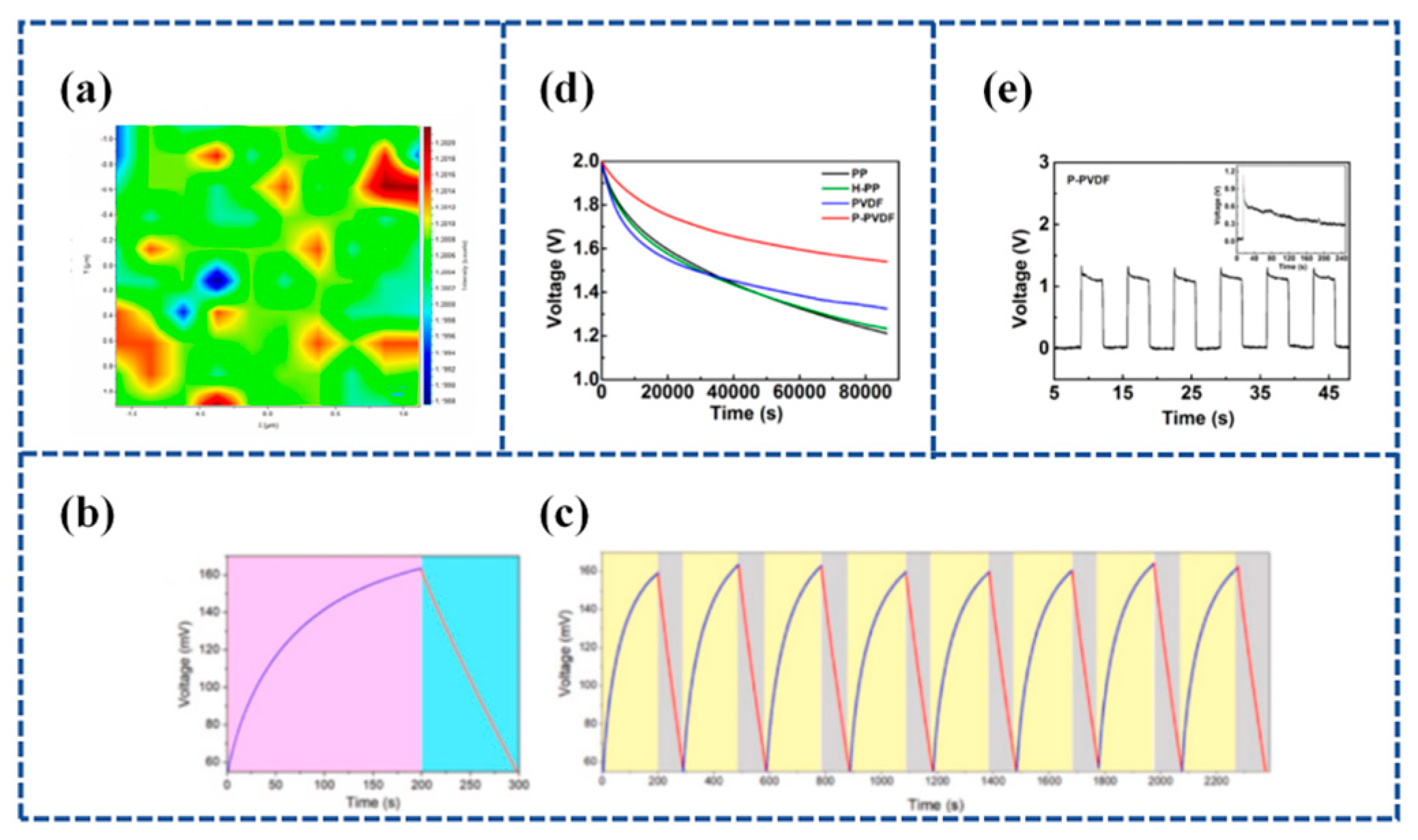
- 2.
- P(VDF-TrFE)
- 3.
- Organic crystals
3.2.4. Flexible SCPSCs Based on Piezoelectric Ion (PI) Effect
4. Current Challenges of Flexible SCSPCs
- Energy Density: One of the main challenges of flexible piezoelectric supercapacitors was their relatively low energy density compared to conventional batteries. Although they can store and release energy quickly, their total energy storage capacity per unit volume was lower than lithium-ion batteries or other traditional energy storage technologies.
- Power Output: While piezoelectric supercapacitors excel in rapid energy release and high power output during piezoelectric deformation, they may not be reliable for applications requiring a continuous and sustained power supply.
- Mechanical Durability: Flexible piezoelectric materials can suffer from mechanical fatigue over time, especially during repeated bending or stretching. This can lead to a decrease in the device’s overall performance and lifespan.
- Charge/Discharge Cycles: The lifespan, that is, the number of charge/discharge cycles a piezoelectric supercapacitor can undergo without significant degradation, is another concern. Frequent and extensive cycling can lead to reduced capacitance and lower energy storage capabilities over time.
- Integration Challenges: Integrating flexible piezoelectric supercapacitors into practical devices or systems may require further research and development to optimize their mechanical, electrical, and structural compatibility.
- Energy Conversion Efficiency: The main disadvantage or limitation of SCSPC devices for practical applications may be the low efficiency of energy conversion and inadequate understanding of energy conversion and storage mechanisms.
5. Conclusions and Perspectives
Author Contributions
Funding
Institutional Review Board Statement
Informed Consent Statement
Data Availability Statement
Conflicts of Interest
Abbreviations
| (ASCs) | Asymmetric Supercapacitors |
| (AFM) | Atomic Force Microscope |
| (AC) | Active Carbon |
| (BT) | Barium–Titanium |
| (CNFs) | Cellulose Nanofibers |
| (CC) | Carbon Cloth |
| (EDL) | Electric Double Layer |
| (EDLC) | Electric Double-Layer Capacitor |
| (GPE) | Gel Polymer Electrolyte |
| (LIB) | Lithium-ion Batteries |
| (NW) | Nanowire |
| (NP) | Nanoparticles |
| (NC) | Nanocomposite |
| (PPy) | Polypyrrole |
| (PTA) | Phosphotungstic Acid |
| (PZT) | Lead Zirconate Titanate |
| (PVA) | Polyvinyl Alcohol |
| (PVDF) | Poly(vinylidene fluoride) |
| P(VDF-TrFE) | Poly(vinylidene fluoride-co-trifluoroethylene) |
| (PENG) | Piezoelectric Nanogenerator |
| (PSCS) | Piezoelectric Self-charging Supercapacitor |
| (PSCFS) | Piezoelectric Self-charging Flexible Supercapacitor |
| (rGO) | Reduced Graphene Oxide |
| (SC) | Supercapacitor |
| (SCAPSC) | Self-charging Asymmetric Piezo-electric Supercapacitor |
| (SCSC) | Self-chargeable Supercapacitor |
| (SCHSC) | Self-charging Hybrid Supercapacitor |
| (SCSPC) | Self-charging Supercapacitor Power Cell |
| (SCPSC) | Self-charging Piezoelectric Supercapacitor |
| (SCHSD) | Self-charging Hybrid Supercapacitor Device |
| (SPSSC) | Self-powered Symmetrical Supercapacitor |
| (XRD) | X-ray Diffraction |
References
- Wang, Z.L.; Song, J. Piezoelectric Nanogenerators Based on Zinc Oxide Nanowire Arrays. Science 2006, 312, 242–246. [Google Scholar] [CrossRef] [PubMed]
- Sabry, R.S.; Hussein, A.D. PVDF: ZnO/BaTiO3 as high out-put piezoelectric nanogenerator. Polym. Test. 2019, 79, 106001. [Google Scholar] [CrossRef]
- Han, S.A.; Kim, T.H.; Kim, S.K.; Lee, K.H.; Park, H.J.; Lee, J.H.; Kim, S.W. Point-Defect-Passivated MoS(2) Nanosheet-Based High Performance Piezoelectric Nanogenerator. Adv. Mater. 2018, 30, e1800342. [Google Scholar] [CrossRef]
- Filippin, A.N.; Sanchez-Valencia, J.R.; Garcia-Casas, X.; Lopez-Flores, V.; Macias-Montero, M.; Frutos, F.; Barranco, A.; Borras, A. 3D core-multishell piezoelectric nanogenerators. Nano Energy 2019, 58, 476–483. [Google Scholar] [CrossRef]
- Jin, D.W.; Ko, Y.J.; Ahn, C.W.; Hur, S.; Lee, T.K.; Jeong, D.G.; Lee, M.; Kang, C.Y.; Jung, J.H. Polarization- and Electrode-Optimized Polyvinylidene Fluoride Films for Harsh Environmental Piezoelectric Nanogenerator Applications. Small 2021, 17, e2007289. [Google Scholar] [CrossRef] [PubMed]
- Niu, X.; Jia, W.; Qian, S.; Zhu, J.; Zhang, J.; Hou, X.; Mu, J.; Geng, W.; Cho, J.; He, J.; et al. High-Performance PZT-Based Stretchable Piezoelectric Nanogenerator. ACS Sustain. Chem. Eng. 2018, 7, 979–985. [Google Scholar] [CrossRef]
- Shi, K.; Sun, B.; Huang, X.; Jiang, P. Synergistic effect of graphene nanosheet and BaTiO3 nanoparticles on performance enhancement of electrospun PVDF nanofiber mat for flexible piezoelectric nanogenerators. Nano Energy 2018, 52, 153–162. [Google Scholar] [CrossRef]
- Wu, T.; Song, Y.; Shi, Z.; Liu, D.; Chen, S.; Xiong, C.; Yang, Q. High-performance nanogenerators based on flexible cellulose nanofibril/MoS2 nanosheet composite piezoelectric films for energy harvesting. Nano Energy 2021, 80, 105541. [Google Scholar] [CrossRef]
- Chen, H.; Zhou, L.; Fang, Z.; Wang, S.; Yang, T.; Zhu, L.; Hou, X.; Wang, H.; Wang, Z.L. Piezoelectric Nanogenerator Based on In Situ Growth All-Inorganic CsPbBr3 Perovskite Nanocrystals in PVDF Fibers with Long-Term Stability. Adv. Funct. Mater. 2021, 31, 2011073. [Google Scholar] [CrossRef]
- Park, K.I.; Son, J.H.; Hwang, G.T.; Jeong, C.K.; Ryu, J.; Koo, M.; Choi, I.; Lee, S.H.; Byun, M.; Wang, Z.L.; et al. Highly-efficient, flexible piezoelectric PZT thin film nanogenerator on plastic substrates. Adv. Mater. 2014, 26, 2514–2520. [Google Scholar] [CrossRef]
- Deng, W.; Zhou, Y.; Libanori, A.; Chen, G.; Yang, W.; Chen, J. Piezoelectric nanogenerators for personalized healthcare. Chem. Soc. Rev. 2022, 51, 3380–3435. [Google Scholar] [CrossRef] [PubMed]
- Ravikumar, A.; Natraj, V.; Sivalingam, Y.; Surya, V.J.; Zheng, F.; Wang, H.; Du, Q.; Liu, N. Piezoelectric nanogenerator induced work function on a metal phenolic coordination framework from copper oxide nanospheres for efficient biomechanical energy harvesting and physiological monitoring. J. Mater. Chem. C 2022, 10, 16492–16505. [Google Scholar] [CrossRef]
- Sahu, M.; Hajra, S.; Jadhav, S.; Panigrahi, B.K.; Dubal, D.; Kim, H.J. Bio-waste composites for cost-effective self-powered breathing patterns monitoring: An insight into energy harvesting and storage properties. Sustain. Mater. Technol. 2022, 32, e00396. [Google Scholar] [CrossRef]
- Li, J.; Yin, J.; Wee, M.G.V.; Chinnappan, A.; Ramakrishna, S. A Self-Powered Piezoelectric Nanofibrous Membrane as Wearable Tactile Sensor for Human Body Motion Monitoring and Recognition. Adv. Fiber Mater. 2023, 5, 1417–1430. [Google Scholar] [CrossRef]
- Li, H.; Lim, S. High-performance piezoelectric nanogenerators featuring embedded organic nanodroplets for self-powered sensors. J. Mater. Chem. A 2022, 10, 14894–14905. [Google Scholar] [CrossRef]
- Li, Y.; Sun, J.; Li, P.; Li, X.; Tan, J.; Zhang, H.; Li, T.; Liang, J.; Zhou, Y.; Hai, Z.; et al. High-performance piezoelectric nanogenerators based on hierarchical ZnO@CF/PVDF composite film for self-power meteorological sensor. J. Mater. Chem. A 2023, 11, 13708–13719. [Google Scholar] [CrossRef]
- Qin, W.; Zhou, P.; Xu, X.; Huang, C.; Srinivasan, G.; Qi, Y.; Zhang, T. High-Performance Piezoelectric Nanogenerator Based on Low-Entropy Structured Nanofibers for a Multi-Mode Energy Harvesting and Self-Powered Ultraviolet Photodetector. ACS Appl. Electron. Mater. 2022, 4, 2970–2978. [Google Scholar] [CrossRef]
- Wu, H.S.; Wei, S.M.; Chen, S.W.; Pan, H.C.; Pan, W.P.; Huang, S.M.; Tsai, M.L.; Yang, P.K. Metal-Free Perovskite Piezoelectric Nanogenerators for Human-Machine Interfaces and Self-Powered Electrical Stimulation Applications. Adv. Sci. 2022, 9, e2105974. [Google Scholar] [CrossRef]
- Yang, P.-K.; Chou, S.-A.; Hsu, C.-H.; Mathew, R.J.; Chiang, K.-H.; Yang, J.-Y.; Chen, Y.-T. Tin disulfide piezoelectric nanogenerators for biomechanical energy harvesting and intelligent human-robot interface applications. Nano Energy 2020, 75, 104879. [Google Scholar] [CrossRef]
- Liu, L.; Guo, X.; Lee, C. Promoting smart cities into the 5G era with multi-field Internet of Things (IoT) applications powered with advanced mechanical energy harvesters. Nano Energy 2021, 88, 106304. [Google Scholar] [CrossRef]
- Hanani, Z.; Izanzar, I.; Amjoud, M.; Mezzane, D.; Lahcini, M.; Uršič, H.; Prah, U.; Saadoune, I.; Marssi, M.E.; Luk’yanchuk, I.A.; et al. Lead-free nanocomposite piezoelectric nanogenerator film for biomechanical energy harvesting. Nano Energy 2021, 81, 105661. [Google Scholar] [CrossRef]
- Bhattacharyya, D.; Badhulika, S. A high performance lead-free flexible piezoelectric nanogenerator based on AlFeO(3)nanorods interspersed in PDMS matrix for biomechanical energy scavenging to sustainably power electronics. Nanotechnology 2023, 34, 285202. [Google Scholar] [CrossRef] [PubMed]
- Zhang, Y.; Mao, J.; Zheng, R.K.; Zhang, J.; Wu, Y.; Wang, X.; Miao, K.; Yao, H.; Yang, L.; Zheng, H. Ferroelectric Polarization-Enhanced Performance of Flexible CuInP2S6 Piezoelectric Nanogenerator for Biomechanical Energy Harvesting and Voice Recognition Applications. Adv. Funct. Mater. 2023, 33, 2214745. [Google Scholar] [CrossRef]
- Veeralingam, S.; Badhulika, S. Lead-Free Transparent Flexible Piezoelectric Nanogenerator for Self-Powered Wearable Electronic Sensors and Energy Harvesting through Rainwater. ACS Appl. Energy Mater. 2022, 5, 12884–12896. [Google Scholar] [CrossRef]
- Egbe, K.-J.I.; Matin Nazar, A.; Jiao, P.; Yang, Y.; Ye, X.; Wang, H. Vibrational turbine piezoelectric nanogenerators for energy harvesting in multiphase flow fields. Energy Rep. 2021, 7, 6384–6393. [Google Scholar] [CrossRef]
- Ma, B.; Cheng, L.; Bai, S.; Jia, X.; Ma, J.; Zhao, J.; Wang, L.; Qin, Y. 3D spirally coiled piezoelectric nanogenerator for large impact energy harvesting. Nano Energy 2023, 111, 108412. [Google Scholar] [CrossRef]
- Jin, L.; Zhang, B.; Zhang, L.; Yang, W. Nanogenerator as new energy technology for self-powered intelligent transportation system. Nano Energy 2019, 66, 104086. [Google Scholar] [CrossRef]
- Hu, D.; Yao, M.; Fan, Y.; Ma, C.; Fan, M.; Liu, M. Strategies to achieve high performance piezoelectric nanogenerators. Nano Energy 2019, 55, 288–304. [Google Scholar] [CrossRef]
- Bairagi, S.; Shahid, I.; Shahadat, M.; Mulvihill, D.M.; Ali, W. Mechanical energy harvesting and self-powered electronic applications of textile-based piezoelectric nanogenerators: A systematic review. Nano Energy 2023, 111, 108414. [Google Scholar] [CrossRef]
- Xu, Q.; Wen, J.; Qin, Y. Development and outlook of high output piezoelectric nanogenerators. Nano Energy 2021, 86, 106080. [Google Scholar] [CrossRef]
- Mokhtari, F.; Foroughi, J.; Zheng, T.; Cheng, Z.; Spinks, G.M. Triaxial braided piezo fiber energy harvesters for self-powered wearable technologies. J. Mater. Chem. A 2019, 7, 8245–8257. [Google Scholar] [CrossRef]
- Liu, M.; Ward, T.; Young, D.; Matos, H.; Wei, Y.; Adams, J.; Yang, K. Electronic textiles based wearable electrotherapy for pain relief. Sens. Actuators A Phys. 2020, 303, 111701. [Google Scholar] [CrossRef]
- Islam, M.R.; Afroj, S.; Novoselov, K.S.; Karim, N. Smart Electronic Textile-Based Wearable Supercapacitors. Adv. Sci. 2022, 9, e2203856. [Google Scholar] [CrossRef] [PubMed]
- Kang, M.; Kim, T.-W. Recent Advances in Fiber-Shaped Electronic Devices for Wearable Applications. Appl. Sci. 2021, 11, 6131. [Google Scholar] [CrossRef]
- An, B.W.; Shin, J.H.; Kim, S.Y.; Kim, J.; Ji, S.; Park, J.; Lee, Y.; Jang, J.; Park, Y.G.; Cho, E.; et al. Smart Sensor Systems for Wearable Electronic Devices. Polymers 2017, 9, 303. [Google Scholar] [CrossRef]
- Karuppaiah, M.; Sakthivel, P.; Asaithambi, S.; Sriram, B.; Ahamad, T.; Alshehri, S.M.; Yuvakkumar, R.; Ravi, G. Heterostructured Ov-Mn2O3@Cu2SnS3@SnS Composite as Battery-Type Cathode Material for Extrinsic Self-Charging Hybrid Supercapacitors. Adv. Mater. Interfaces 2022, 9, 2200104. [Google Scholar] [CrossRef]
- Sreekanth, J.V.; Sambath Kumar, K.; Seal, S.; Rajaraman, S.; Thomas, J. Fiber-Type Solar Cells, Nanogenerators, Batteries, and Supercapacitors for Wearable Applications. Adv. Sci. 2018, 5, 1800340. [Google Scholar]
- García Núñez, C.; Manjakkal, L.; Dahiya, R. Energy autonomous electronic skin. Npj Flex. Electron. 2019, 3, 1. [Google Scholar] [CrossRef]
- Ma, W.; Li, X.; Lu, H.; Zhang, M.; Yang, X.; Zhang, T.; Wu, L.; Cao, G.; Song, W. A flexible self-charged power panel for harvesting and storing solar and mechanical energy. Nano Energy 2019, 65, 104082. [Google Scholar] [CrossRef]
- González-Arribas, E.; Aleksejeva, O.; Bobrowski, T.; Toscano, M.D.; Gorton, L.; Schuhmann, W.; Shleev, S. Solar biosupercapacitor. Electrochem. Commun. 2017, 74, 9–13. [Google Scholar] [CrossRef]
- Wang, T.; Guo, Y.; Wan, P.; Zhang, H.; Chen, X.; Sun, X. Flexible Transparent Electronic Gas Sensors. Small 2016, 12, 3748–3756. [Google Scholar] [CrossRef] [PubMed]
- Gao, F.; Song, J.; Teng, H.; Luo, X.; Ma, M. All-polymer ultrathin flexible supercapacitors for electronic skin. Chem. Eng. J. 2021, 405, 126915. [Google Scholar] [CrossRef]
- An, J.; Le, T.D.; Huang, Y.; Zhan, Z.; Li, Y.; Zheng, L.; Huang, W.; Sun, G.; Kim, Y.J. All-Graphene-Based Highly Flexible Noncontact Electronic Skin. ACS Appl. Mater. Interfaces 2017, 9, 44593–44601. [Google Scholar] [CrossRef]
- Ding, G.; Chen, R.S.; Xie, P.; Yang, B.; Shang, G.; Liu, Y.; Gao, L.; Mo, W.A.; Zhou, K.; Han, S.T.; et al. Filament Engineering of Two-Dimensional h-BN for a Self-Power Mechano-Nociceptor System. Small 2022, 18, e2200185. [Google Scholar] [CrossRef]
- Gao, S.; Zhu, Y.; Chen, Y.; Tian, M.; Yang, Y.; Jiang, T.; Wang, Z.L. Self-power electroreduction of N2 into NH3 by 3D printed triboelectric nanogenerators. Mater. Today 2019, 28, 17–24. [Google Scholar] [CrossRef]
- Khan, M.U.; Abbas, Y.; Rezeq, M.; Alazzam, A.; Mohammad, B. Unidirectional Neuromorphic Resistive Memory Integrated with Piezoelectric Nanogenerator for Self-Power Electronics. Adv. Funct. Mater. 2023, 2305869. [Google Scholar] [CrossRef]
- Jeong, Y.; Shin, D.; Park, J.H.; Park, J.; Yi, Y.; Im, S. Integrated advantages from perovskite photovoltaic cell and 2D MoTe2 transistor towards self-power energy harvesting and photosensing. Nano Energy 2019, 63, 103833. [Google Scholar] [CrossRef]
- Li, W.; Lin, K.; Chen, L.; Yang, D.; Ge, Q.; Wang, Z. Self-Powered Wireless Flexible Ionogel Wearable Devices. ACS Appl. Mater. Interfaces 2023, 15, 14768–14776. [Google Scholar] [CrossRef]
- Jiang, C.; Li, X.; Lian, S.W.M.; Ying, Y.; Ho, J.S.; Ping, J. Wireless Technologies for Energy Harvesting and Transmission for Ambient Self-Powered Systems. ACS Nano 2021, 15, 9328–9354. [Google Scholar] [CrossRef]
- Yang, X.Y.; Feng, X.L.; Jin, X.; Shao, M.Z.; Yan, B.L.; Yan, J.M.; Zhang, Y.; Zhang, X.B. An Illumination-Assisted Flexible Self-Powered Energy System Based on a Li-O(2) Battery. Angew. Chem. Int. Ed. Engl. 2019, 58, 16411–16415. [Google Scholar] [CrossRef]
- Huang, J.; Ren, Z.; Zhang, Y.; Fong, P.W.K.; Chandran, H.T.; Liang, Q.; Yao, K.; Tang, H.; Xia, H.; Zhang, H.; et al. Tandem Self-Powered Flexible Electrochromic Energy Supplier for Sustainable All-Day Operations. Adv. Energy Mater. 2022, 12, 2201042. [Google Scholar] [CrossRef]
- Park, S.; Heo, S.W.; Lee, W.; Inoue, D.; Jiang, Z.; Yu, K.; Jinno, H.; Hashizume, D.; Sekino, M.; Yokota, T.; et al. Self-powered ultra-flexible electronics via nano-grating-patterned organic photovoltaics. Nature 2018, 561, 516–521. [Google Scholar] [CrossRef] [PubMed]
- Luo, Z.; Wang, Y.; Kou, B.; Liu, C.; Zhang, W.; Chen, L. “Sweat-chargeable” on-skin supercapacitors for practical wearable energy applications. Energy Storage Mater. 2021, 38, 9–16. [Google Scholar] [CrossRef]
- Covaci, C.; Gontean, A. Piezoelectric Energy Harvesting Solutions: A Review. Sensors 2020, 20, 3512. [Google Scholar] [CrossRef]
- Clementi, G.; Cottone, F.; Di Michele, A.; Gammaitoni, L.; Mattarelli, M.; Perna, G.; López-Suárez, M.; Baglio, S.; Trigona, C.; Neri, I. Review on Innovative Piezoelectric Materials for Mechanical Energy Harvesting. Energies 2022, 15, 6227. [Google Scholar] [CrossRef]
- Wang, Z. Modeling and Simulation of Piezoelectrically Driven Self-Charging Lithium Ion Batteries. ACS Appl. Mater. Interfaces 2017, 9, 15893–15897. [Google Scholar] [CrossRef]
- Selleri, G.; Poli, F.; Neri, R.; Gasperini, L.; Gualandi, C.; Soavi, F.; Fabiani, D. Energy harvesting and storage with ceramic piezoelectric transducers coupled with an ionic liquid-based supercapacitor. J. Energy Storage 2023, 60, 106660. [Google Scholar] [CrossRef]
- Shao, Y.; El-Kady, M.F.; Sun, J.; Li, Y.; Zhang, Q.; Zhu, M.; Wang, H.; Dunn, B.; Kaner, R.B. Design and Mechanisms of Asymmetric Supercapacitors. Chem. Rev. 2018, 118, 9233–9280. [Google Scholar] [CrossRef]
- Silambarasan, S.; Maiyalagan, T. Nitrogen-doped porous carbon coated on MnCo2O4 nanospheres as electrode materials for high-performance asymmetric supercapacitors. Mater. Today Chem. 2023, 27, 101350. [Google Scholar] [CrossRef]
- Yoo, H.D.; Han, S.D.; Bayliss, R.D.; Gewirth, A.A.; Genorio, B.; Rajput, N.N.; Persson, K.A.; Burrell, A.K.; Cabana, J. “Rocking-Chair”-Type Metal Hybrid Supercapacitors. ACS Appl. Mater. Interfaces 2016, 8, 30853–30862. [Google Scholar] [CrossRef]
- Whiteley, J.M.; Hafner, S.; Han, S.S.; Kim, S.C.; Le, V.-D.; Ban, C.; Kim, Y.H.; Oh, K.H.; Lee, S.-H. All-solid-state disordered LiTiS2pseudocapacitor. J. Mater. Chem. A 2017, 5, 15661–15668. [Google Scholar] [CrossRef]
- Lee, D.W.; Lee, J.H.; Min, N.K.; Jin, J.H. Buckling Structured Stretchable Pseudocapacitor Yarn. Sci. Rep. 2017, 7, 12005. [Google Scholar] [CrossRef] [PubMed]
- Xiao, Y.; Liu, Y.; Liu, F.; Han, P.; Qin, G. Wearable pseudocapacitor based on porous MnO2 composite. J. Alloys Compd. 2020, 813, 152089. [Google Scholar] [CrossRef]
- Huang, C.; Qin, P.; Li, D.; Ruan, Q.; Song, H.; Liu, L.; Wu, Y.; Ma, Y.; Li, Q.; Huo, K.; et al. Origin of superior pseudocapacitive mechanism of transition metal nitrides. J. Energy Chem. 2022, 69, 561–568. [Google Scholar] [CrossRef]
- Kong, W.; Ge, X.; Yang, M.; Zhang, Q.; Lu, J.; Wen, H.; Wen, H.; Kong, D.; Zhang, M.; Zhu, X.; et al. Poly-p-phenylene as a novel pseudocapacitive anode or cathode material for hybrid capacitive deionization. Desalination 2023, 553, 116452. [Google Scholar] [CrossRef]
- Cui, Y.; Zhao, L.; Pan, H.; Zhao, C.; Wang, J.; Meng, L.; Yu, H.; Zhao, B.; Chen, X.; Yang, J.; et al. ZIF-9 derived rGO/NiCo2S4 composite as the electrode materials for high performance asymmetric supercapacitor. Microchem. J. 2023, 190, 108718. [Google Scholar] [CrossRef]
- Ye, W.; Wang, H.; Ning, J.; Zhong, Y.; Hu, Y. New types of hybrid electrolytes for supercapacitors. J. Energy Chem. 2021, 57, 219–232. [Google Scholar] [CrossRef]
- Sun, X.; Zhao, K.; Fu, H.; Guo, H.; Shen, J.; Jin, F.; Wang, L.; Wang, Z.; Cui, L.; Quan, F.; et al. Heterostructure of MnSe2@NiCo2Se4 as novel electrode material for high-performance asymmetric supercapacitors. J. Energy Storage 2023, 63, 107041. [Google Scholar] [CrossRef]
- Sahoo, S.; Ratha, S.; Rout, C.S.; Nayak, S.K. Self-charging supercapacitors for smart electronic devices: A concise review on the recent trends and future sustainability. J. Mater. Sci. 2022, 57, 4399–4440. [Google Scholar] [CrossRef]
- Jiang, Z.; Zhai, S.; Huang, M.; Songsiriritthigul, P.; Aung, S.H.; Oo, T.Z.; Luo, M.; Chen, F. 3D carbon nanocones/metallic MoS2 nanosheet electrodes towards flexible supercapacitors for wearable electronics. Energy 2021, 227, 120419. [Google Scholar] [CrossRef]
- Dubal, D.P.; Chodankar, N.R.; Kim, D.H.; Gomez-Romero, P. Towards flexible solid-state supercapacitors for smart and wearable electronics. Chem. Soc. Rev. 2018, 47, 2065–2129. [Google Scholar] [CrossRef] [PubMed]
- Yang, Y.; Hoang, M.T.; Bhardwaj, A.; Wilhelm, M.; Mathur, S.; Wang, H. Perovskite solar cells based self-charging power packs: Fundamentals, applications and challenges. Nano Energy 2022, 94, 106910. [Google Scholar] [CrossRef]
- Zhang, Y.; Zhang, Y.; Xue, X.; Cui, C.; He, B.; Nie, Y.; Deng, P.; Lin Wang, Z. PVDF-PZT nanocomposite film based self-charging power cell. Nanotechnology 2014, 25, 105401. [Google Scholar] [CrossRef] [PubMed]
- Zhao, C.; Sun, X.; Li, W.; Shi, M.; Ren, K.; Lu, X. Reduced Self-Discharge of Supercapacitors Using Piezoelectric Separators. ACS Appl. Energy Mater. 2021, 4, 8070–8075. [Google Scholar] [CrossRef]
- Zhan, C.; Zhang, P.; Dai, S.; Jiang, D.-e. Boron Supercapacitors. ACS Energy Lett. 2016, 1, 1241–1246. [Google Scholar] [CrossRef]
- Liu, T.; Yan, R.; Huang, H.; Pan, L.; Cao, X.; DeMello, A.; Niederberger, M. A Micromolding Method for Transparent and Flexible Thin-Film Supercapacitors and Hybrid Supercapacitors. Adv. Funct. Mater. 2020, 30, 2004410. [Google Scholar] [CrossRef]
- Say, M.G.; Brooke, R.; Edberg, J.; Grimoldi, A.; Belaineh, D.; Engquist, I.; Berggren, M. Spray-coated paper supercapacitors. Npj Flex. Electron. 2020, 4, 14. [Google Scholar] [CrossRef]
- Yu, L.; Chen, G.Z. Ionic Liquid-Based Electrolytes for Supercapacitor and Supercapattery. Front. Chem. 2019, 7, 272. [Google Scholar] [CrossRef]
- Iqbal, M.Z.; Aziz, U. Supercapattery: Merging of battery-supercapacitor electrodes for hybrid energy storage devices. J. Energy Storage 2022, 46, 103823. [Google Scholar] [CrossRef]
- Kiruthika, S.; Sneha, N.; Gupta, R. Visibly transparent supercapacitors. J. Mater. Chem. A 2023, 11, 4907–4936. [Google Scholar] [CrossRef]
- Cheng, J.; Hu, S.-C.; Sun, G.-T.; Kang, K.; Zhu, M.-Q.; Geng, Z.-C. Comparison of activated carbons prepared by one-step and two-step chemical activation process based on cotton stalk for supercapacitors application. Energy 2021, 215, 119144. [Google Scholar] [CrossRef]
- Karuppaiah, M.; Sriram, B.; Sakthivel, P.; Asaithambi, S.; Sidharth, D.; Balaji, V.; Wang, S.F.; Yuvakkumar, R.; Ravi, G. Mesoporous oxygen vacancy 3D-rhombohedral Ov-Mn2O3 mixed with rGO@CNTs as cathode material for self-charging pouch-type hybrid supercapacitor applications. Mater. Today Chem. 2022, 26, 101017. [Google Scholar] [CrossRef]
- Padha, B.; Verma, S.; Arya, S. Fabric-Based Wearable Self-Powered Asymmetric Supercapacitor Comprising Lead-Free Perovskite Piezoelectrodes. Adv. Mater. Technol. 2022, 7, 2200079. [Google Scholar] [CrossRef]
- Selvam, S.; Park, Y.K.; Yim, J.H. Design and Testing of Autonomous Chargeable and Wearable Sweat/Ionic Liquid-Based Supercapacitors. Adv. Sci. 2022, 9, e2201890. [Google Scholar] [CrossRef]
- Lee, J.; Shen, F.; Miao, S.; Ryu, G.H.; Im, B.; Kim, D.G.; An, G.-H.; Cho, Y. Enhanced spontaneous self-charging through scalable template-free surface engineering at building block fiber scale for wearable electronics. Nano Energy 2022, 104, 107891. [Google Scholar] [CrossRef]
- Ren, X.; Xiang, X.; Yin, H.; Tang, Y.; Yuan, H. All-yarn triboelectric nanogenerator and supercapacitor based self-charging power cloth for wearable applications. Nanotechnology 2021, 32, 315404. [Google Scholar] [CrossRef]
- Kil, H.J.; Kim, S.R.; Park, J.W. A Self-Charging Supercapacitor for a Patch-Type Glucose Sensor. ACS Appl. Mater. Interfaces 2022, 14, 3838–3848. [Google Scholar] [CrossRef]
- Maitra, A.; Bera, R.; Halder, L.; Bera, A.; Paria, S.; Karan, S.K.; Si, S.K.; De, A.; Ojha, S.; Khatua, B.B. Photovoltaic and triboelectrification empowered light-weight flexible self-charging asymmetric supercapacitor cell for self-powered multifunctional electronics. Renew. Sustain. Energy Rev. 2021, 151, 111595. [Google Scholar] [CrossRef]
- Wang, N.; Dou, W.; Hao, S.; Cheng, Y.; Zhou, D.; Huang, X.; Jiang, C.; Cao, X. Tactile sensor from self-chargeable piezoelectric supercapacitor. Nano Energy 2019, 56, 868–874. [Google Scholar] [CrossRef]
- Wu, S.; Zabihi, F.; Yeap, R.Y.; Darestani, M.R.Y.; Bahi, A.; Wan, Z.; Yang, S.; Servati, P.; Ko, F.K. Cesium Lead Halide Perovskite Decorated Polyvinylidene Fluoride Nanofibers for Wearable Piezoelectric Nanogenerator Yarns. ACS Nano 2023, 17, 1022–1035. [Google Scholar] [CrossRef]
- Nair, K.S.; Varghese, H.; Chandran, A.; Hareesh, U.N.S.; Chouprik, A.; Spiridonov, M.; Surendran, K.P. Synthesis of KNN nanoblocks through surfactant-assisted hot injection method and fabrication of flexible piezoelectric nanogenerator based on KNN-PVDF nanocomposite. Mater. Today Commun. 2022, 31, 103291. [Google Scholar] [CrossRef]
- Yang, L.; Li, J.; Zhang, P.; Qiu, J.; Feng, Y.; Cao, M.; Yao, J. Self-chargeable zinc-ion hybrid supercapacitor driven by salt-concentrated cellulose hydrogel. Cellulose 2021, 28, 11483–11492. [Google Scholar] [CrossRef]
- Ankinapalli, O.R.; Krishna, B.N.V.; Yu, J.S. Facile hydrothermal synthesized MoV2O8/MoO3 microclusters-based electrode materials for high-capacity asymmetric supercapacitors. J. Alloys Compd. 2023, 948, 169770. [Google Scholar] [CrossRef]
- Qin, C.; Lu, A. Flexible, anti-freezing self-charging power system composed of cellulose based supercapacitor and triboelectric nanogenerator. Carbohydr. Polym. 2021, 274, 118667. [Google Scholar] [CrossRef] [PubMed]
- Zhang, T.; Xie, L.; Li, J.; Huang, Z.; Lei, H.; Liu, Y.; Wen, Z.; Xie, Y.; Sun, X. All-in-One Self-Powered Human-Machine Interaction System for Wireless Remote Telemetry and Control of Intelligent Cars. Nanomaterials 2021, 11, 2711. [Google Scholar] [CrossRef] [PubMed]
- Singh, B.; Padha, B.; Verma, S.; Satapathi, S.; Gupta, V.; Arya, S. Recent advances, challenges, and prospects of piezoelectric materials for self-charging supercapacitor. J. Energy Storage 2022, 47, 103547. [Google Scholar] [CrossRef]
- Ramadoss, A. Piezoelectric-Driven Self-Charging Supercapacitor Power Cell. ACS Nano 2015, 9, 4337–4345. [Google Scholar] [CrossRef]
- Jagadale, A.D.; Rohit, R.C.; Shinde, S.K.; Kim, D.Y. Review—Mitigating Supercapacitor Self-Discharge Through Strategic Materials Modification. J. Electrochem. Soc. 2021, 168, 090562. [Google Scholar] [CrossRef]
- Zhou, D.; Wang, N.; Yang, T.; Wang, L.; Cao, X.; Wang, Z.L. A piezoelectric nanogenerator promotes highly stretchable and self-chargeable supercapacitors. Mater. Horiz. 2020, 7, 2158–2167. [Google Scholar] [CrossRef]
- Dousti, B.; Babu, S.; Geramifard, N.; Choi, M.Y.; Lee, J.B.; Cogan, S.F.; Lee, G.S. Highly flexible all-solid-state microsupercapacitors for on chip applications using a transfer-free fabrication process. J. Power Sources 2022, 520, 230779. [Google Scholar] [CrossRef]
- Hoffmann, A.; Jimenez-Calvo, P.; Bansmann, J.; Strauss, V.; Kuehne, A.J.C. On-Chip Direct Laser Writing of PAN-Based Carbon Supercapacitor Electrodes. Macromol. Rapid Commun. 2022, 43, e2100731. [Google Scholar] [CrossRef] [PubMed]
- Gassab, M.; Chebil, A.; Dridi, C. Predictive Study of Electrical Performances of Interdigitated, Cost-Effective Supercapacitor for Autonomous Microsystems. Arab. J. Sci. Eng. 2021, 47, 1043–1051. [Google Scholar] [CrossRef]
- Sahoo, S.; Krishnamoorthy, K.; Pazhamalai, P.; Mariappan, V.K.; Manoharan, S.; Kim, S.J. High performance self-charging supercapacitors using a porous PVDF-ionic liquid electrolyte sandwiched between two-dimensional graphene electrodes. J. Mater. Chem. A 2019, 7, 21693–21703. [Google Scholar] [CrossRef]
- Cao, L.; Yang, S.; Gao, W.; Liu, Z.; Gong, Y.; Ma, L.; Shi, G.; Lei, S.; Zhang, Y.; Zhang, S.; et al. Direct laser-patterned micro-supercapacitors from paintable MoS2 films. Small 2013, 9, 2905–2910. [Google Scholar] [CrossRef] [PubMed]
- Li, X.; Li, H.; Fan, X.; Shi, X.; Liang, J. 3D-Printed Stretchable Micro-Supercapacitor with Remarkable Areal Performance. Adv. Energy Mater. 2020, 10, 1903794. [Google Scholar] [CrossRef]
- Zhang, C.J.; Kremer, M.P.; Seral-Ascaso, A.; Park, S.-H.; McEvoy, N.; Anasori, B.; Gogotsi, Y.; Nicolosi, V. Stamping of Flexible, Coplanar Micro-Supercapacitors Using MXene Inks. Adv. Funct. Mater. 2018, 28, 1705506. [Google Scholar] [CrossRef]
- Gilshteyn, E.P.; Amanbaev, D.; Silibin, M.V.; Sysa, A.; Kondrashov, V.A.; Anisimov, A.S.; Kallio, T.; Nasibulin, A.G. Flexible self-powered piezo-supercapacitor system for wearable electronics. Nanotechnology 2018, 29, 325501. [Google Scholar] [CrossRef]
- Rasheed, A.; He, W.; Qian, Y.; Park, H.; Kang, D.J. Flexible Supercapacitor-Type Rectifier-free Self-Charging Power Unit Based on a Multifunctional Polyvinylidene Fluoride-ZnO-rGO Piezoelectric Matrix. ACS Appl. Mater. Interfaces 2020, 12, 20891–20900. [Google Scholar] [CrossRef]
- No, I.-J.; Jeong, D.-Y.; Lee, S.; Kim, S.-H.; Cho, J.-W.; Shin, P.-K. Enhanced charge generation of the ZnO nanowires/PZT hetero-junction based nanogenerator. Microelectron. Eng. 2013, 110, 282–287. [Google Scholar] [CrossRef]
- Sarkar, L.; Sushma, M.V.; Yalagala, B.P.; Rengan, A.K.; Singh, S.G.; Vanjari, S.R.K. ZnO nanoparticles embedded silk fibroin-a piezoelectric composite for nanogenerator applications. Nanotechnology 2022, 33, 265403. [Google Scholar] [CrossRef]
- Zhang, R.; Hummelgård, M.; Olsen, M.; Örtegren, J.; Olin, H. Nanogenerator made of ZnO nanosheet networks. Semicond. Sci. Technol. 2017, 32, 054002. [Google Scholar] [CrossRef]
- Cui, X.; Ni, X.; Zhang, Y. Theoretical study of output of piezoelectric nanogenerator based on composite of PZT nanowires and polymers. J. Alloys Compd. 2016, 675, 306–310. [Google Scholar] [CrossRef]
- Chen, X.; Xu, S.; Yao, N.; Shi, Y. 1.6 V nanogenerator for mechanical energy harvesting using PZT nanofibers. Nano Lett. 2010, 10, 2133–2137. [Google Scholar] [CrossRef] [PubMed]
- Deshmukh, V.V.; Harini, H.V.; Nagaswarupa, H.P.; Naik, R.; Ravikumar, C.R. Development of novel Co3+ doped LaMnO3 perovskite electrodes for supercapacitors and sensors: Mechanism of electrochemical energy storage and oxygen intercalation. J. Energy Storage 2023, 68, 107805. [Google Scholar] [CrossRef]
- Tomar, A.K.; Joshi, A.; Singh, G.; Sharma, R.K. Perovskite oxides as supercapacitive electrode: Properties, design and recent advances. Coord. Chem. Rev. 2021, 431, 213680. [Google Scholar] [CrossRef]
- Rabani, I.; Park, Y.-J.; Lee, J.-W.; Tahir, M.S.; Kumar, A.; Seo, Y.-S. Ultra-thin flexible paper of BNNT–CNF/ZnO ternary nanostructure for enhanced solid-state supercapacitor and piezoelectric response. J. Mater. Chem. A 2022, 10, 15580–15594. [Google Scholar] [CrossRef]
- Veeralingam, S.; Gunasekaran, S.S.; Badhulika, S. Bifunctional NiFe LDH as a piezoelectric nanogenerator and asymmetric pseudo-supercapacitor. Mater. Chem. Front. 2022, 6, 2297–2308. [Google Scholar] [CrossRef]
- Maheshwaran, G.; Prabhu, M.R.; Ravi, G.; Sankaranarayanan, K.; Sudhahar, S. Probing the energy conversion and storage process in two dimensional layered bismuthene-hexagonal boron nitride nanocomposite electrode and PVA-KOH-BaTiO3 piezoelectrolyte nanogenerators. Nano Energy 2023, 106, 108060. [Google Scholar] [CrossRef]
- Zhou, D.; Wang, F.; Yang, J.; Fan, L.-z. Flexible solid-state self-charging supercapacitor based on symmetric electrodes and piezo-electrolyte. Chem. Eng. J. 2021, 406, 126825. [Google Scholar] [CrossRef]
- Subhramaniyan Rasappan, A.; Palanisamy, R.; Thangamuthu, V.; Natarajan, M.; Velauthapillai, D.; Kim, J. Cubic-architectured tungsten sulfide @ Cu-Fe bimetallic electrodes for dye-sensitized solar cells, hybrid supercapacitors, and piezoelectric nanogenerators. Nano Energy 2023, 112, 108490. [Google Scholar] [CrossRef]
- Wu, L.; Jin, Z.; Liu, Y.; Ning, H.; Liu, X.; Alamusi; Hu, N. Recent advances in the preparation of PVDF-based piezoelectric materials. Nanotechnol. Rev. 2022, 11, 1386–1407. [Google Scholar] [CrossRef]
- De Adhikari, A.; Singh, S.; Lahiri, I. WS2@PPy heterostructured high performance supercapacitor self-powered by PVDF piezoelectric separator. J. Alloys Compd. 2023, 939, 168713. [Google Scholar] [CrossRef]
- Nardekar, S.S.; Krishnamoorthy, K.; Pazhamalai, P.; Sahoo, S.; Jae Kim, S. MoS2 quantum sheets-PVDF nanocomposite film based self-poled piezoelectric nanogenerators and photovoltaically self-charging power cell. Nano Energy 2022, 93, 106869. [Google Scholar] [CrossRef]
- Pusty, M.; Shirage, P.M. Insights and perspectives on graphene-PVDF based nanocomposite materials for harvesting mechanical energy. J. Alloys Compd. 2022, 904, 164060. [Google Scholar] [CrossRef]
- Pazhamalai, P.; Krishnamoorthy, K.; Mariappan, V.K.; Sahoo, S.; Manoharan, S.; Kim, S.-J. A High Efficacy Self-Charging MoSe2 Solid-State Supercapacitor Using Electrospun Nanofibrous Piezoelectric Separator with Ionogel Electrolyte. Adv. Mater. Interfaces 2018, 5, 1800055. [Google Scholar] [CrossRef]
- Mondal, S.; Thakur, S.; Maiti, S.; Bhattacharjee, S.; Chattopadhyay, K.K. Self-Charging Piezo-Supercapacitor: One-Step Mechanical Energy Conversion and Storage. ACS Appl. Mater. Interfaces 2023, 15, 8446–8461. [Google Scholar] [CrossRef]
- Manoharan, S.; Pazhamalai, P.; Mariappan, V.K.; Murugesan, K.; Subramanian, S.; Krishnamoorthy, K.; Kim, S.-J. Proton conducting solid electrolyte-piezoelectric PVDF hybrids: Novel bifunctional separator for self-charging supercapacitor power cell. Nano Energy 2021, 83, 105753. [Google Scholar] [CrossRef]
- Lu, Y.; Jiang, Y.; Lou, Z.; Shi, R.; Chen, D.; Shen, G. Wearable supercapacitor self-charged by P(VDF-TrFE) piezoelectric separator. Progress. Nat. Sci. Mater. Int. 2020, 30, 174–179. [Google Scholar] [CrossRef]
- Gao, X.; Zhang, Y.; Zhao, Y.; Yin, S.; Gui, J.; Sun, C.; Guo, S. Heterointerface engineering and piezoelectric effect enhanced performance of self-charging supercapacitors power cell. Nano Energy 2022, 91, 106701. [Google Scholar] [CrossRef]
- Verma, S.; Arya, S.; Gupta, V.; Khosla, A. Highly stable self-charging piezoelectric (Rochelle salt) driven supercapacitor based on Ni nanowires. Chem. Eng. J. 2021, 424, 130567. [Google Scholar] [CrossRef]
- Krishnamoorthy, K.; Manoharan, S.; Mariappan, V.K.; Pazhamalai, P.; Kim, S.-J. Decoupling mechano- and electrochemical gating: A direct visualization for piezo-ionic propelled proton tunneling in self-charging supercapacitors. J. Mater. Chem. A 2022, 10, 7818–7829. [Google Scholar] [CrossRef]
- Pazhamalai, P.; Krishnamoorthy, K.; Manoharan, S.; Mariappan, V.K.; Kim, S.-J. Monolithic integration of MoS2 quantum sheets on solid electrolyte for self-charging supercapacitor power cell governed by piezo-ionic effect. Sustain. Mater. Technol. 2022, 33, e00459. [Google Scholar] [CrossRef]
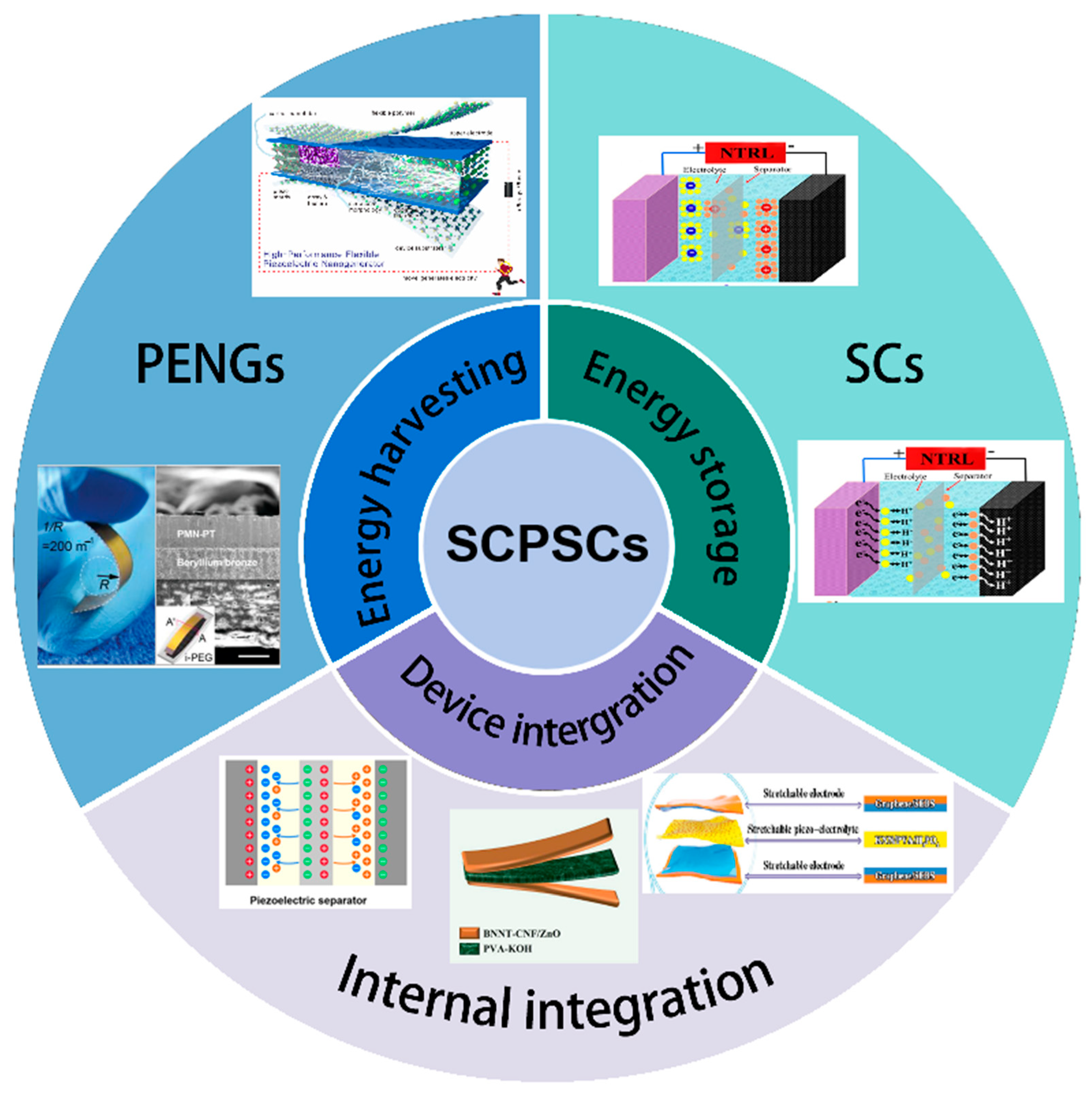
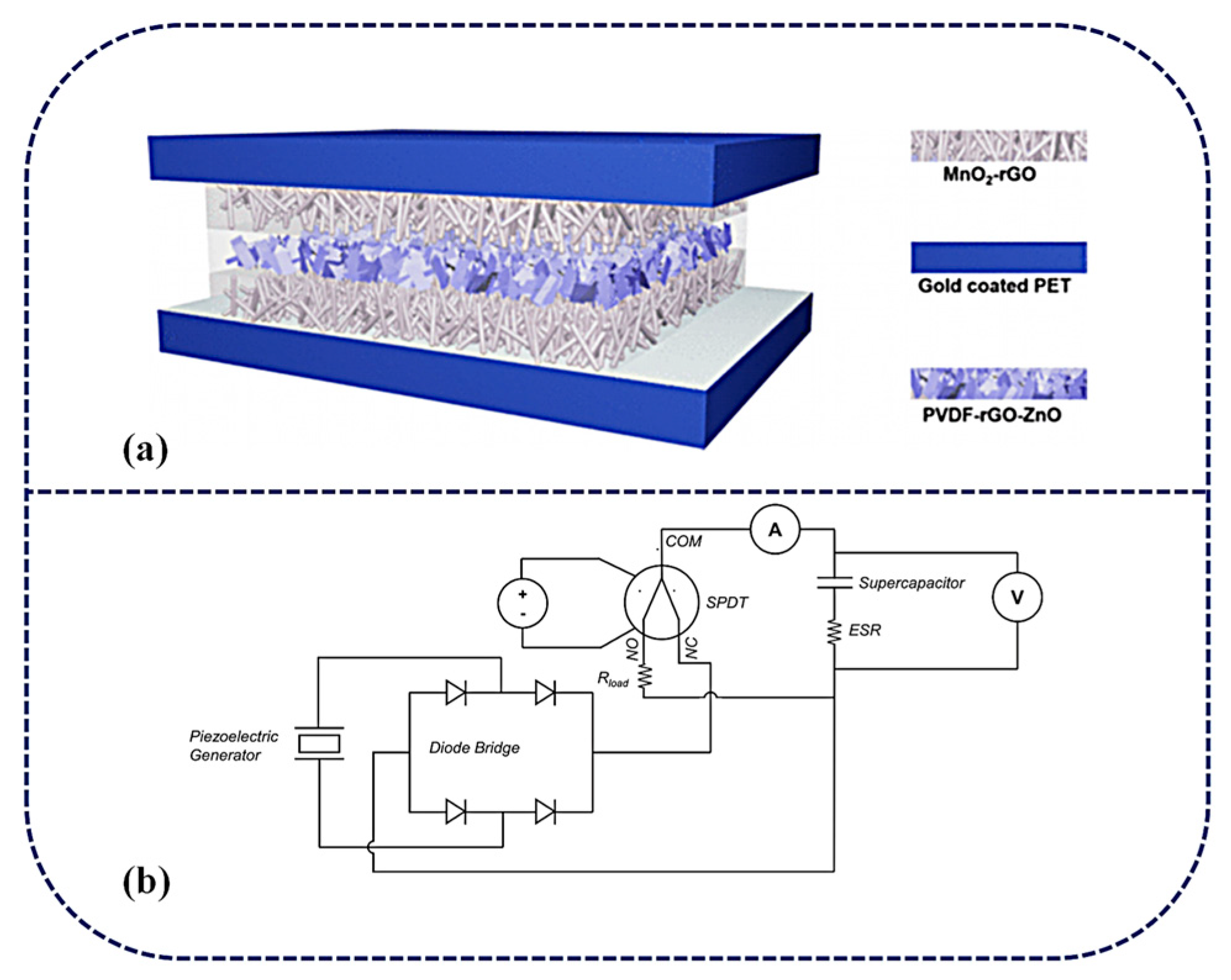
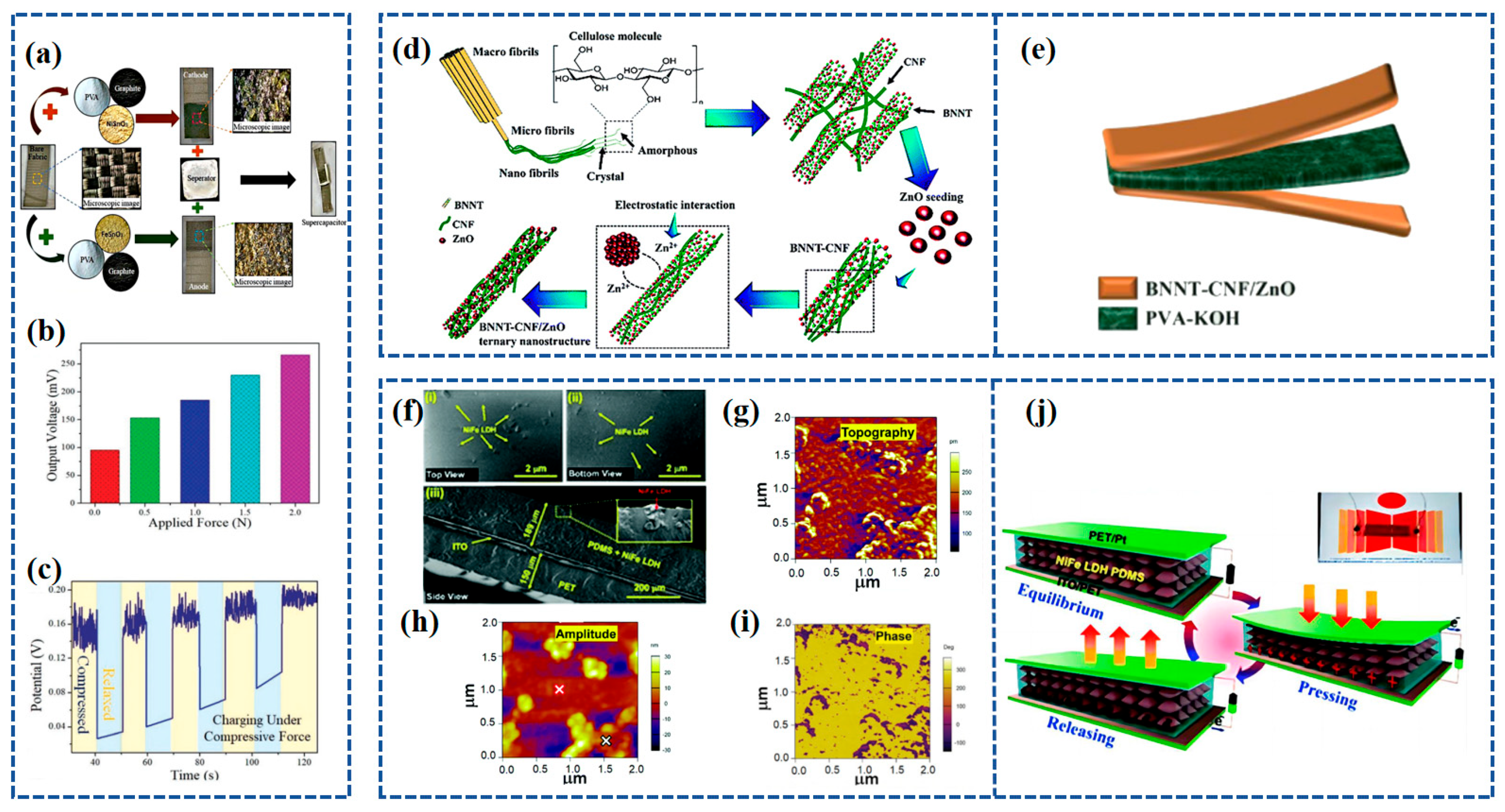

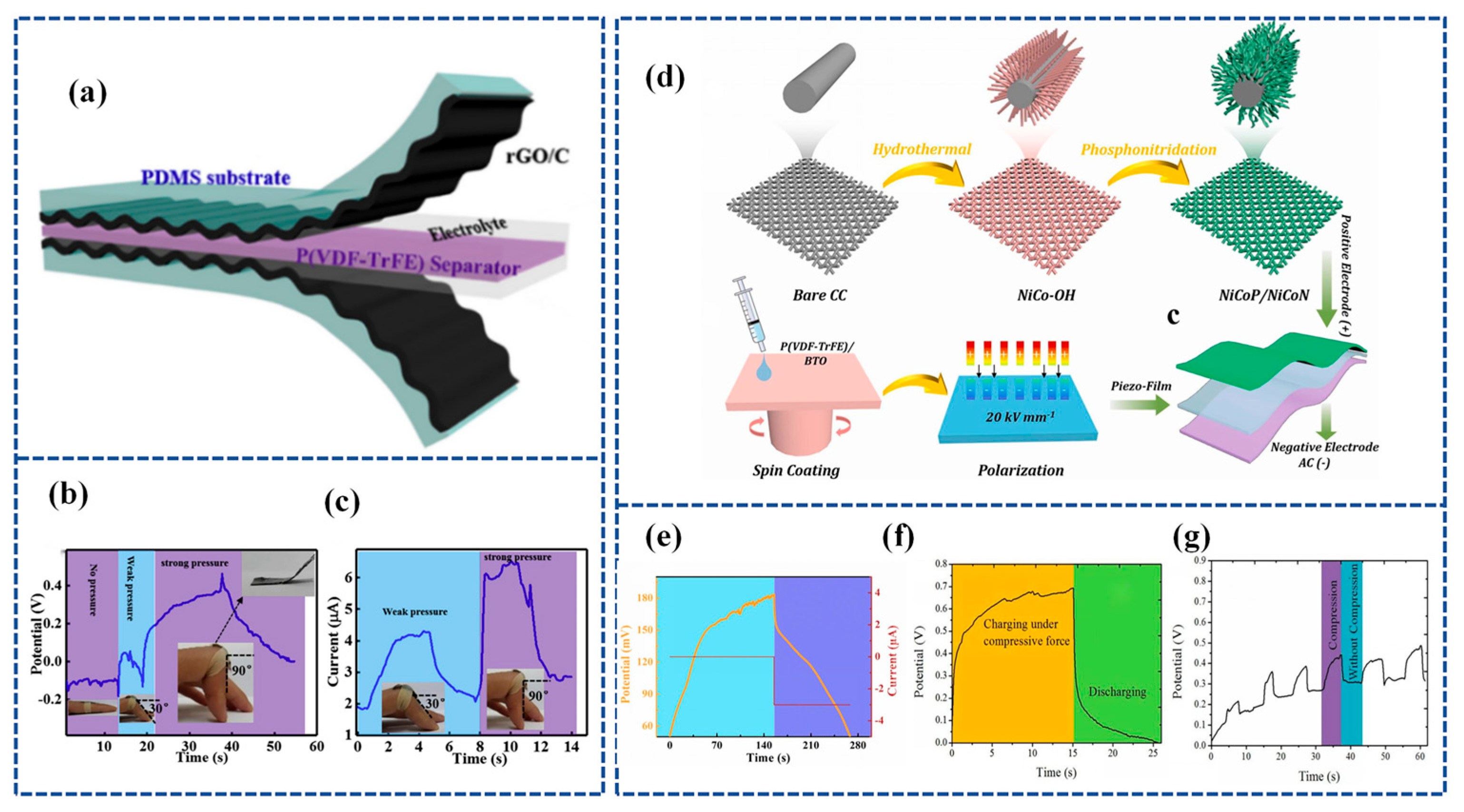
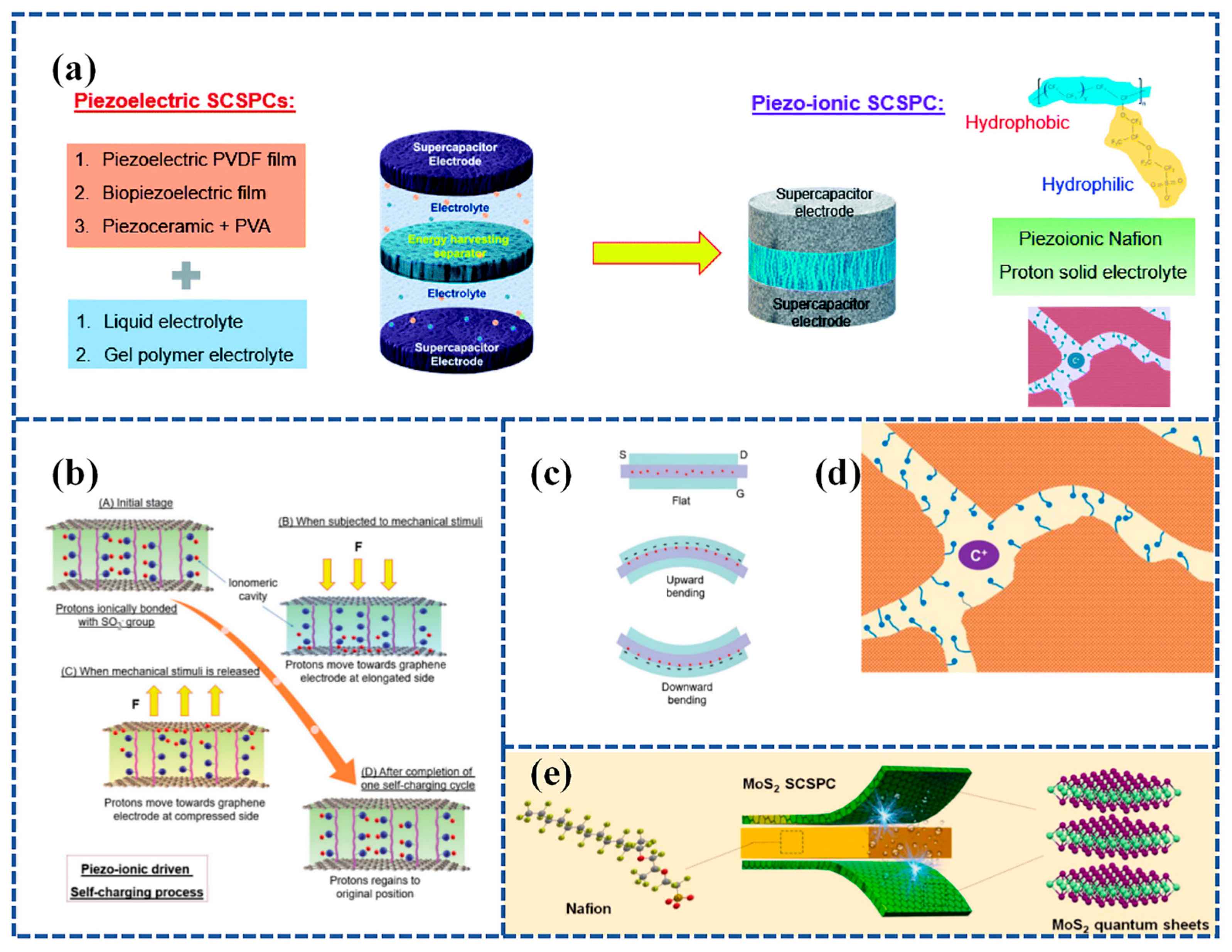
Disclaimer/Publisher’s Note: The statements, opinions and data contained in all publications are solely those of the individual author(s) and contributor(s) and not of MDPI and/or the editor(s). MDPI and/or the editor(s) disclaim responsibility for any injury to people or property resulting from any ideas, methods, instructions or products referred to in the content. |
© 2023 by the authors. Licensee MDPI, Basel, Switzerland. This article is an open access article distributed under the terms and conditions of the Creative Commons Attribution (CC BY) license (https://creativecommons.org/licenses/by/4.0/).
Share and Cite
Meng, S.; Wang, N.; Cao, X. Built-In Piezoelectric Nanogenerators Promote Sustainable and Flexible Supercapacitors: A Review. Materials 2023, 16, 6916. https://doi.org/10.3390/ma16216916
Meng S, Wang N, Cao X. Built-In Piezoelectric Nanogenerators Promote Sustainable and Flexible Supercapacitors: A Review. Materials. 2023; 16(21):6916. https://doi.org/10.3390/ma16216916
Chicago/Turabian StyleMeng, Shuchang, Ning Wang, and Xia Cao. 2023. "Built-In Piezoelectric Nanogenerators Promote Sustainable and Flexible Supercapacitors: A Review" Materials 16, no. 21: 6916. https://doi.org/10.3390/ma16216916





